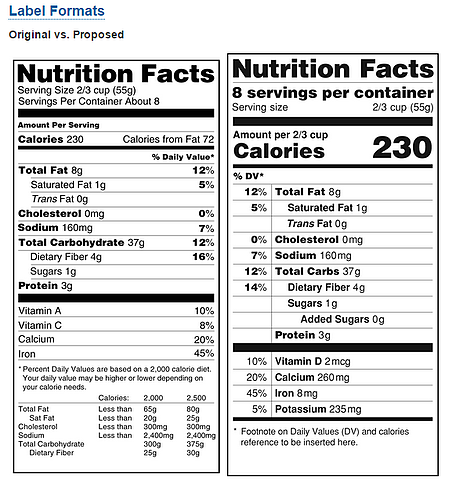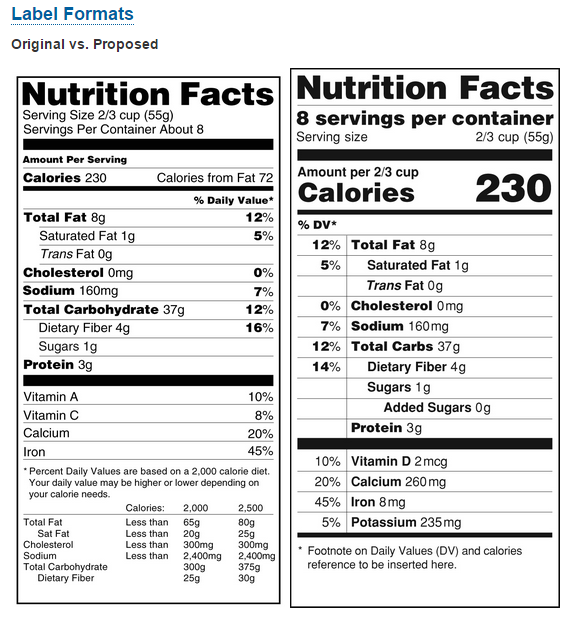It used to be that the American consumer didn’t have much to go on when trying to make nutritionally savvy shopping decisions. It wasn’t until the Nutrition Labeling and Education Act (NLEA) of 1990 that most packaged foods were required to bear nutrition and ingredient labeling. Perhaps even more importantly, it also established the requirement that all health claims made regarding foods meet the federal definition of these claims. In 1993 the standardized nutrition facts label was introduced.
 Since then, there have been some other big changes— not only nationally, but also at state and local levels. Here’s what’s happened at the federal level. In 2003, the FDA announced that they would require food labels to include trans-fat content. Then in 2004, the Food Allergy Labeling and Consumer Protection Act was passed, requiring label identification for all foods that contain a protein derived from one of the eight allergens that account for 90% of the food allergies in America. More recently, in 2013 the FDA finalized the definition of ‘gluten free,’ which dictates that any product with ‘gluten free’ claims on the label must have less than 20 ppm of gluten in the product, among other requirements. Just this past November, the FDA passed regulations requiring nutrition labeling for certain products on menus.
Since then, there have been some other big changes— not only nationally, but also at state and local levels. Here’s what’s happened at the federal level. In 2003, the FDA announced that they would require food labels to include trans-fat content. Then in 2004, the Food Allergy Labeling and Consumer Protection Act was passed, requiring label identification for all foods that contain a protein derived from one of the eight allergens that account for 90% of the food allergies in America. More recently, in 2013 the FDA finalized the definition of ‘gluten free,’ which dictates that any product with ‘gluten free’ claims on the label must have less than 20 ppm of gluten in the product, among other requirements. Just this past November, the FDA passed regulations requiring nutrition labeling for certain products on menus.
In 2014, the FDA has also proposed certain changes to the nutrition facts panel. These nutrition label changes aim to make it easier for Americans to make smarter food choices, thereby improving their health. Take a look below at what to expect:

- Greater emphasis on the calories of a product as well as the servings per container. This will be done by increasing the font size and bolding the calorie information. “Calories from Fat” will also be removed because the type of fat is more important than the amount of calories from fat.
- Serving sizes will be updated to reflect the amounts that people actually eat as opposed to what they should eat. This will provide a more realistic idea of how much a person is actually consuming.
- The % daily values (%DVs) for nutrients will be updated and shifted to the left of the nutrition facts panel. This is meant to bring more attention to the %DVs. These are included on the label to help consumers understand how each nutrient should fit in relation to the entire daily diet.
- Added sugars will be included on the label. This means that instead of just listing the amount of sugars in product, the amount of sugars from added sweeteners will be called out. This is to help consumers decipher between sources of sugars such as fruits versus white sugar.
- The micronutrients listed at the bottom of the nutrition facts panel will now only include Vitamin D, Calcium, Iron, and Potassium. This is because data shows that Americans are not consuming enough of these nutrients which play particular importance in bone health and cardiovascular health.
Here’s a side to side comparison of the old and new (proposed) nutrition labels:
 What do you think of the proposed changes? Let us know in the comments.
What do you think of the proposed changes? Let us know in the comments.
Get more information on the proposed nutrition labeling requirements on the FDA’s website.
Read more about how to decipher food product labeling and nutritional value here:
• How to Tell if a Product is Whole Grain
• Bread Additives: Who Needs Them? We’ll Stick to Our Slow Food Methods
• What is the Difference Between Yogurt and Greek Yogurt?
• Whole Grain Breads Are Full of Nutrition, Not Marketing





